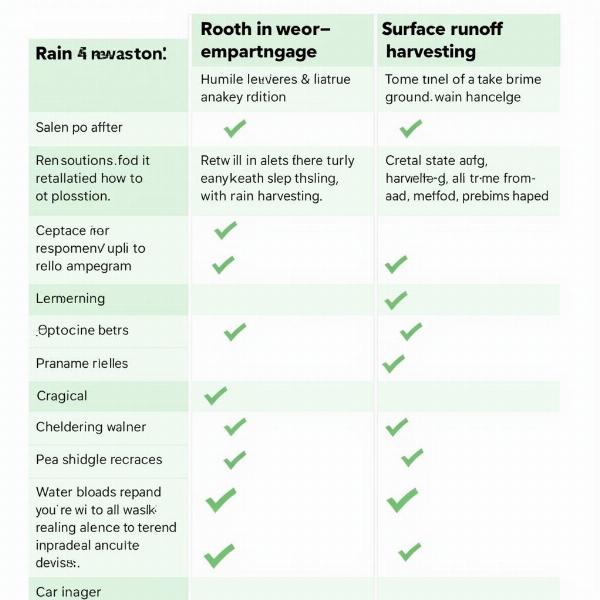Rain harvesting, a practice as old as civilization itself, gains increasing importance in modern India. Understanding its meaning in Hindi, along with its practical applications, is crucial for addressing water scarcity and promoting sustainable living. But what exactly does “rain harvesting meaning in Hindi” signify, and why is it so vital in the Indian context?
What Does Rain Harvesting Mean in Hindi?
Rain harvesting in Hindi is translated as “वर्षा जल संचयन” (Varsha Jal Sanchayan). “Varsha” (वर्षा) means rain, “Jal” (जल) means water, and “Sanchayan” (संचयन) means collection or storage. This simple yet powerful phrase encapsulates the essence of the practice: collecting and storing rainwater for later use. This practice is deeply rooted in traditional Indian water management techniques, highlighting the importance of water conservation in a predominantly agricultural society.
Why is Rain Harvesting Important in India?
India faces a growing water crisis, with increasing demand from agriculture, industry, and a burgeoning population. Rain harvesting offers a practical and sustainable solution to alleviate this pressure. It replenishes groundwater levels, reduces dependence on municipal water supply, and mitigates the impact of droughts. Furthermore, it promotes self-sufficiency and empowers communities to manage their water resources effectively. In essence, rain harvesting is not just about collecting water; it’s about securing a sustainable future.
Different Methods of Rain Harvesting
Rain harvesting encompasses various methods, each tailored to specific needs and environments. Rooftop harvesting, the most common method, involves collecting rainwater from rooftops and directing it to storage tanks. Surface runoff harvesting captures rainwater flowing over land surfaces, while groundwater recharge techniques focus on replenishing underground aquifers. The choice of method depends on factors such as rainfall patterns, land topography, and water requirements.
 Comparison of Rain Harvesting Methods
Comparison of Rain Harvesting Methods
Benefits of Rain Harvesting: Beyond Water Conservation
The benefits of rain harvesting extend beyond mere water conservation. It improves water quality by reducing reliance on potentially contaminated sources. It reduces soil erosion and flooding by controlling surface runoff. Moreover, it promotes environmental awareness and encourages community participation in water management. By adopting rain harvesting, individuals and communities contribute to a more sustainable and resilient future.
Rain Harvesting and Sustainable Development
Rain harvesting aligns perfectly with the principles of sustainable development. It contributes to water security, a key component of the Sustainable Development Goals (SDGs). By empowering communities to manage their water resources, it fosters economic growth and social equity. Furthermore, it reduces the environmental footprint associated with conventional water supply systems.
How can individuals contribute to rain harvesting?
Implementing rain harvesting at the household level can be a simple yet impactful step. Installing a basic rooftop harvesting system can provide a substantial amount of water for non-potable uses like gardening and cleaning. This not only reduces dependence on municipal water but also raises awareness about water conservation within the family.
Conclusion
Understanding “rain harvesting meaning in Hindi” – वर्षा जल संचयन – goes beyond a simple translation. It signifies a crucial step towards water security and sustainable living in India. By embracing this traditional practice and adapting it to modern contexts, individuals and communities can contribute to a brighter, water-secure future.
FAQ
- What is the easiest way to start rain harvesting at home? Installing a rooftop harvesting system is the most accessible option for most households.
- Is rainwater safe for drinking? Rainwater collected through rooftop harvesting should be filtered and treated before drinking.
- Are there any government incentives for rain harvesting? Several states in India offer subsidies and tax benefits for implementing rain harvesting systems.
- How much water can be saved through rain harvesting? The amount of water saved depends on factors like rainfall, roof area, and storage capacity.
- What is the cost of setting up a rain harvesting system? Costs vary depending on the complexity and size of the system.
Meaning-Hindi.in, a leading Hindi translation service provider, offers expert translation services across various domains, including technical, legal, and educational documents. Our expertise in Hindi language and Indian culture ensures accurate and culturally sensitive translations. Need professional Hindi translation services? Contact us today at [email protected] or call us at +91 11-4502-7584. Meaning-Hindi.in is your trusted partner for all your Hindi translation needs.